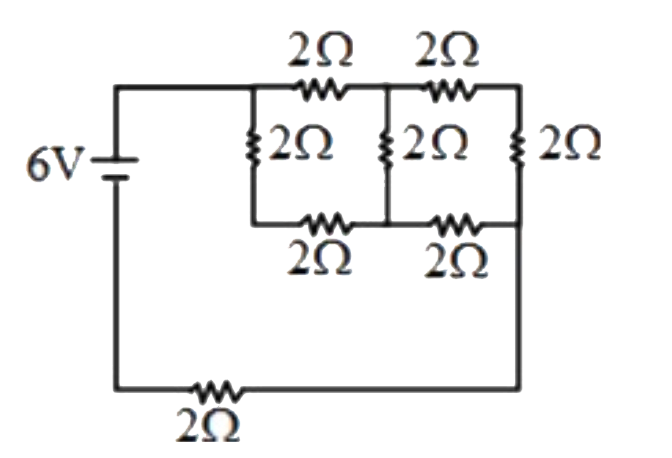When a current drawn from a battery is 0.5 A its terminal potential difference is 20 V. And when current drawn from it is 2.0 A, the terminal voltage reduces to 16 V. Find out. e.m.f and internal resistance of the bettery.
To solve the problem, we need to find the electromotive force (e.m.f) and the internal resistance of the battery using the given data. We will use the formula for terminal voltage, which is given by:
V=E−I⋅r
where:
- V is the terminal voltage,
- E is the e.m.f of the battery,
- I is the current flowing through the circuit,
- r is the internal resistance of the battery.
Step 1: Set up the equations based on the given data
1. When the current I1=0.5A, the terminal voltage V1=20V:
20=E−0.5r(Equation 1)
2. When the current I2=2.0A, the terminal voltage V2=16V:
16=E−2r(Equation 2)
Step 2: Solve the equations simultaneously
We have two equations:
1. 20=E−0.5r
2. 16=E−2r
From Equation 1, we can express E:
E=20+0.5r(Equation 3)
Now, substitute Equation 3 into Equation 2:
16=(20+0.5r)−2r
Step 3: Simplify and solve for r
Rearranging the equation:
16=20+0.5r−2r
16=20−1.5r
1.5r=20−16
1.5r=4
r=41.5=83≈2.67Ω
Step 4: Substitute r back to find E
Now that we have r, substitute it back into Equation 3 to find E:
E=20+0.5(83)
E=20+43
E=603+43=643≈21.33V
Final Answers
- The e.m.f of the battery E≈21.33V
- The internal resistance of the battery r≈2.67Ω
- V is the terminal voltage,
- E is the e.m.f of the battery,
- I is the current flowing through the circuit,
- r is the internal resistance of the battery.
20=E−0.5r(Equation 1)
16=E−2r(Equation 2)
1. 20=E−0.5r
2. 16=E−2r
E=20+0.5r(Equation 3)
16=(20+0.5r)−2r
16=20+0.5r−2r
16=20−1.5r
1.5r=20−16
1.5r=4
r=41.5=83≈2.67Ω
E=20+0.5(83)
E=20+43
E=603+43=643≈21.33V
- The internal resistance of the battery r≈2.67Ω
Topper's Solved these Questions
- CURRENT ELECTRICITYBOOK - NARAYNACHAPTER - CURRENT ELECTRICITYEXERCISE - C.U.Q
105 Videos
- CURRENT ELECTRICITYBOOK - NARAYNACHAPTER - CURRENT ELECTRICITYEXERCISE - Level 1 C.W
64 Videos
- COMMUNICATION SYSTEMBOOK - NARAYNACHAPTER - COMMUNICATION SYSTEMEXERCISE - Level-II(H.W)
25 Videos
- DUAL NATURE OF RADIATION AND MATTERBOOK - NARAYNACHAPTER - DUAL NATURE OF RADIATION AND MATTEREXERCISE - ASSERTION AND REASON
15 Videos
Similar Questions
When a current drawn from a battery is 0.5 A, its terminal potential difference is 20 V. And when current drawn from it is 0.2 A, the terminal voltage reduces to 16 V. Find out, emf and internal resistance of the battery.
View SolutionWhat is the current drawn from the battery of 6 V ?

View Solution
Knowledge Check
As the current drawn from the cell increases, terminal potential difference of a cell is
AconstantBdecreasesCincreasesDnone of theseWhen current supplied by a cell to a circuit is 0.3A, its terminal potential difference is 0.9 A. When the current supplied becomes 0.2 A, its terminal potential difference becomes 1.0 V . The internal resistance of the cell is
A0.5ΩB2ΩC1.2ΩD1ΩWhen current supplied by a cell to a circuit is 0.3A, its terminal potential difference is 0.9 A. When the current supplied becomes 0.2 A, its terminal potential difference becomes 1.0 V . The internal resistance of the cell is
A0.5ΩB2ΩC1.2ΩD1Ω
The potential difference across a cell is 1.8 V when a current of 0.5 A is drawn from it. The p.d. falls to 1.6 V when a current of 1.0 A is drawn. Find the emf and the internal resistance of the cell.
View SolutionWhen a bettery is connected to the resistance of 10Ω the current in the circuit is 0.12 A the same battery gives 0.07A current with 20Ω calculate e.m.f and internal resistance of the battery.
View SolutionFor a cell, the terminal potential difference is 2.2V, when circuit is open and reduces to 1.8V. When cell is connected to a resistance R=5Ω, the internal resistance of cell (R) is
View SolutionWhen a current of 2 A flows in a battery from negative to positive terminal, the potential difference across it is 20 V. If a current of 3 A flowing in the opposite direction produces a potential difference of 25 V, the emf of the battery is
View SolutionA straight line plot showing the terminal potential difference (V) of a cell as a function of current (1) drawn from it, is shown in the figure. The internal resistance of the cell would be then:

View Solution
